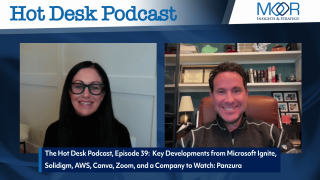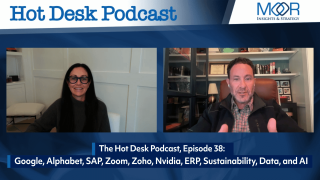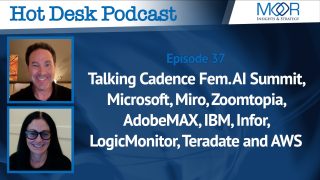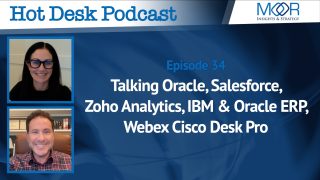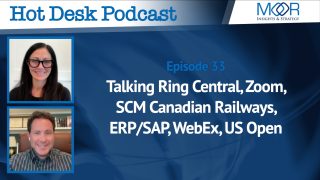It’s Episode 36 of the Hot Desk Podcast. Melody Brue has Telco/5G SME guests Anshel Sag and Will Townsend to discuss Hurricane Helene disaster response, T-Mobile’s first responder solutions, Verizon’s relief grants, and how to help in Helene recovery. Come along!
Watch the full episode here:
Listen to the audio here:
00:36 Hurricane Helene Disaster Relief
12:32 T-Mobile First Responders Solutions – Can it Complement AT&T FirstNet?
17:52 Verizon Disaster Relief Grants
21:33 Red Cross Donation
Hurricane Helene Disaster Relief
> T-Mobile Responding to Hurricane Helene
> AT&T Response to Hurricane Helene
> Verizon Hurricane Helene Emergency Response Updates
T-Mobile First Responders Solutions – Can it Complement AT&T FirstNet?
> T-Mobile Introduces ‘T-Priority’ Featuring the World’s First Network Slice for First Responders
> T-Mobile Government: First Responders – Connecting Heroes
Verizon Disaster Relief Grants
> Learn more about Verizon’s Hurricane Helene Relief Grants
Red Cross Donation
> Donate to Red Cross Hurricane Helene Relief Efforts
> Mobile option: Text REDCROSS to 90999 to donate
Disclaimer: This show is for information and entertainment purposes only. While we will discuss publicly traded companies on this show. The contents of this show should not be taken as investment advice.
TRANSCRIPT
Melody Brue: Hi, welcome to this week’s edition of More Insights and Strategy Hot Desk podcast. I’m Melody Brue and I am joined today by a couple of subject matter experts. I have Anshel Sag Will Townsend. Hi guys, how are you doing?
Will Townsend: Hey, Mel.
Melody Brue: Glad to have you. So this is really kind of a special treat. We usually, on this show, we talk about all the tools, trends, trajectories in people and marketing technology, enterprise apps, E-R-P-C-R-M, all those things. But there’s a lot of it, right?
Will Townsend: A long list.
Melody Brue: But today I really wanted for you guys to help shed some light on what’s been happening in terms of Hurricane Helene and the disaster recovery. I recall when the Maui fires were happening, you guys were really on top of what the carriers were doing, how they were keeping people connected, some of the kind of relief efforts. And I’ve noticed some things. I’ve also seen just friends and family who weren’t able to reach their loved ones for days Posting on Facebook like, please, if you’ve seen these people, and I continue to see the death toll rising. I mean, it’s just really tragic. But there are solutions, and I think even, I hate to say this, but from a business opportunity, there are opportunities for companies to, one, offer their services, but really make kind of an impact on both their customers and the goodwill, if you would, because these are really important things when we talk about even stadiums, that they have to be connected in case of a disaster. Well, now we really have a disaster and these companies are showing up and doing various things. So I’d love to hear from you guys if you want to start maybe, I don’t know which one of you wants to take this, whoever, but I have seen quite a bit from T-Mobile and their response. And tell me, let’s talk about what’s going on there and also the importance of the need.
Anshel Sag: Do you want me to, I’ll chime in with some of the non-career specific things I’ve seen and then I’ll let will fill in and then if there’s anything I have additional thoughts on, I’ll add more. I’ll say non-career specific. I’ve seen a lot of iPhone users using the new satellite communications feature to communicate with friends and family. When cell networks were down, that was the first phase of what I saw. I saw a lot of people using Starlink to communicate with people to get internet access even when there wasn’t power. And then more so satellite has become a big supporter for both individuals and for the carriers to bring data, network access where power lines are severed, fiber lines are severed, all these things. So I’ll say as setting the stage, cellular is great, but satellite in these situations becomes like a lifeline. And we’ve seen a lot of talk about Starlink, a little bit of maybe over talk about Starlink when it comes to this could have solved every problem under the rural sun. But the reality is in these situations, satellite technologies, whether it’s Starlink or Global Star, any other satellite provider that’s being offered today, they’re all options. Even Google Pixel now has satellite communications on the Pixel nine series. So if you’re a Google Pixel nine user, iPhone 16- 15, those are all going to have satellite communications when the cell services are down. And as a slight note, when Verizon Network services were down this week, I had cell communications on my iPhone, so I wasn’t totally out of service there, but I’d love to let will fill in on the carrier side.
Will Townsend: Yeah, first and foremost, it’s just tragic to see what’s happened. Helene was a category four. I have a home in the Florida Keys, and I’m always very nervous when it’s hurricane season. And again, my heart goes out to those individuals that have been affected. I mean, Asheville, North Carolina has been wiped off the face of the earth. It’s a beautiful place and it’s just sad. Let me start first on the satellite piece that Anshel brought up and then I’ll go specifically into some of the efforts that the mobile network operators are employing to restore service. And the good news is, as of today, the majority of service has been restored. But number one, it’s clear to me that the knowledge about satellite communications in low earth orbit is very high. Now, Starlink, Elon Musk was on X talking about turning on service, not charging customers as a stop gap. I agree with Anshel I mean, Starlink has a lot of limitations from a bandwidth perspective and a cost perspective to make it something that could serve as sort of a redundancy, a cost effective redundancy. But I think that’s great. I’ve also seen a lot of activity on social media with people talking about AST SpaceMobile and Anshel and I, we’ve had time with AT & T and AST and I did a podcast last week with Chris Sambar and with Abel Avellan from AST Space Mobile. A lot of folks on social media, it’s like, Hey, let’s get AST out there. Hey, shouldn’t AST functionality be integrated into a notebook? It’s still verying, it’s still very, very new. But satellite can become a very critical element to helping bridge digital divide. And we’re going to go into a little more detail there, but specifically, I was very impressed with all the mobile network operators and their efforts.
T-Mobile is an example, bringing in satellite cell on light trucks, very small aperture terminals to restore connectivity very quickly, Verizon providing charging centers AT & T, leveraging a huge drone to basically use a drone to function as a radio access network tower I, and to see all of the equipment that’s marshaled to do this. But you also have to remember, there’s got to be a concerted coordination effort as well. You don’t want people bumping into one another. And these are times when even these mobile network operators, T-Mobile at t and Verizon, they’re so competitive, but they come together and they work together. And I think it’s a fantastic demonstration of the relief effort.
Melody Brue: Yeah, I agree. I think that’s great. One thing that came up, I think in both things that you talked about, device side and the network side was bridging the digital divide and the cost. So Anshel, a lot of the phones that you talked about, these are higher end phones, but a lot of these areas that were impacted are rural areas where people are already strapped financially. So this is even devastating for them. So what are some of the efforts that these companies, I mean besides giving people better phones because that’s just not an option, where are they helping to connect people who don’t have the means for a Starlink?
Anshel Sag: Yeah, so a good example of that is actually T-Mobile. They actually set up wifi and device charging stations. So that way if you don’t have cell service or satellite service, you can go to a place where there is wifi that they’ve set up. Obviously, that’s not the end all, be all solution. I actually believe, and this is something Will and I have talked about for quite some time, that as satellite communications becomes more prevalent at the high end, it will become table stakes and it’ll become necessary and mandatory. I believe European and American regulators will mandate cellular service, I mean satellite service as a safety feature for all smartphones. I don’t know when that will happen, but I believe within the next five to 10 years that will be mandatory. And as a result of that, we’ll have a lot more people getting emergency services help where they need it, whether it’s a catastrophe like Helene or somebody in the middle of nowhere where there’s no cell service. One of the big things that T-Mobile actually did recently with Starlink was an emergency message test basically across the entire country. Basically showing how if there is a fire in your area, a wildfire and you happen to be in that zip code, they can fire off a wildfire warning to people who might otherwise have absolutely no idea there’s a wildfire and potentially save lives.
So you can only get those text message notifications if you have cell service, but if you have satellite, you can still get those warnings pretty much anywhere you have line of sight to the sky. So I think with time, this capability will move down the chain. I think satellite communications needs to become more prevalent. It can’t just be a premium feature to your point, but I think that might take a few more years for it to become real. I believe 20 26, 20 27 will likely be when it becomes mainstream. I think a lot of people in the industry have that view. But other than that, I think there’s a lot of opportunities for first responders to use satellite as well and potentially help families connect with their loved ones that way. But right now, you’re right, it is definitely a gap. And my sister lives in South Carolina, so I’ve been tracking a lot of the flooding pretty closely. And she told me that one of her favorite towns in North Carolina was completely wiped off the map. It doesn’t exist anymore, so it’s just horrible. I’m really thankful that where she lives in Greenville, I believe has power now. So it’s difficult in the south because it gets pretty hot and AC is super important, especially with her and her two cats.
Will Townsend: But hey, Anshel, just to kind of follow up on your point, the reason why it’s going to take a while to find its footing is that we’re still in the very early stages. So AST Space mobile just launched its first five commercial satellites and going to be a number of waves of satellites that are going to be launched to provide the necessary coverage and support for Leo. Starlink is still in its testing phase with direct to cell unmodified cell phone. So I agree with Anshel, it’s, it’s going to take a few years to get there once we get there. It’s also going to be interesting to determine how the mobile network operators will monetize this. I mean, certainly in times of natural disaster, there should be some sort of suspension of charges. And we’ve seen that happen with mobile network operators where they suspend billing and that’s the right thing to do, but there is quite a bit of investment to make NTN integrate into these terrestrial networks. And so it is going to be interesting to see how the AT & T’s and the T-Mobile’s and the Verizon’s of the world and also Vodafone, because Vodafone is now a big investor in AST space mobile along with AT & T, it’s going to be interesting to see how they monetize those investments.
Anshel Sag: And I’ll just add to your point, adding to my point that the chip sets in the phones will soon have satellite connectivity integrated into them at the chip level. So it won’t be a separate chip like it is today. And it will be the NTN network standard as opposed to proprietary stuff. So that’s probably going to be coming the next year or two. So if device makers don’t really have to do much in terms of spend on chips and software and it’s just integrated in the operating system, Google supports it, apple supports it. So we’re getting there. It’ll be a couple of years, but it’ll be one of those things where it’s part of the feature list, it’s not even a special thing anymore.
Melody Brue: Yeah. So we talked a lot about how this affects consumers and probably businesses as well, but I think one of the really important things that I’ve seen is how, and this was announced before the hurricane, but how some of the network operators are looking are prioritizing first responders communication. So T-Mobile with their T priority network slice for first responders, that to me kind of hits home. I have a brother who’s a law enforcement officer in Florida, actually. I’ve seen him go through many of these events. And I also have school aged children, and I hate to say it, but those are the things that freak me out when if there’s a major disaster that the people are jamming the networks and the first responders need to have, they’re communication prioritized. So talk about what T-Mobile and others are doing on that front.
Will Townsend: I’ll take that Mel, and then let Anshel comment. So he and I were at the T-Mobile Market Capital Day Capital Markets Day,
Melody Brue: Capital Markets Day, yeah.
Will Townsend: A few weeks ago, and this is when T priority was rolled out. It’s interesting because T-Mobile has the most ubiquitous standalone network, they can actually start network slicing. And this isn’t the first slice that they’ve announced earlier in the year, they did announce a security slice that compliments their SIM based SASS e offering. So this is another example of how T-Mobile is leaning into its standalone leadership to slice a network to deliver deterministic connectivity. And it’s interesting because there’s also AT & T FirstNet, and that’s something that Anshel and I have talked about on many occasions, that is a separate dedicated network for first responders. And so the first question I had when this was announced, when T-Mobile announced this was like, okay, is this kind of redundant? Is it going to compliment what AT & T FirstNet has accomplished? And I think it’s a good thing. I think it can compliment FirstNet. I mean, FirstNet is a dedicated network for first responders, but in these situations where there may be local law enforcement are not on, and fire and EMS that are not on FirstNet, many are the T-Mobile priority slice can really serve a great purpose and again, deliver that deterministic support. Because you think about a lot of drones now, and I’ll let Anshel take this one because he’s a drone fanatic. A lot of drones now are used to fly in initially to these areas to survey the damage and determine where are they going to bring mobile satellite infrastructure. Anshel, you want to talk about that a little bit?
Anshel Sag: Yeah. So first of all, AT &T does this on the commercial network regularly. Whenever there’s an outage, they verify with a drone and then they send out a work order, someone works on it, and then they send a drone to verify. But for this specific application, I believe AT & T also sent out drones for damage assessments for inaccessible areas. Because think about all the roads that are washed out right now. You can’t send a truck out there. So they’re sending out drones to verify which cells need work and which ones are operational, and then they can start to plan how they’re going to recover once they do have access. So this was a conversation I had with AT &T’s like COO or CTO six years ago, if not longer. So they’ve really kind of been working on this for a long time, and they’re kind of the experts, in my opinion, when it comes to utilizing drones for this application. So I wouldn’t be surprised if Verizon and T-Mobile are doing the same thing. But I have a feeling that AT & T’s is probably the most mature use of drones.
Will Townsend: Yeah, I would agree.
Melody Brue: It’s amazing how far things have come. I mean, I’ve been in and around the wireless industry for 25 years now, about as long as you’ve been in the business since you started your tech career at what four? The youngster as a toddler-
Anshel Sag: The bald one.
Melody Brue: But we saw the first introductions of the ruggedized phones, and then it was being able to-
Anshel Sag: Get the flip out antenna for satellite.
Melody Brue: And so it’s amazing to see the advancements and how much it actually affects the public when something like this happens. And I know Will, you had said or written something about how a lot of these companies are really transforming from consumer oriented businesses to addressing public sector mobility service needs. And I think that’s a really important thing. Obviously with the disaster stuff. How else are they kind of helping with this beyond that? I know Verizon is doing some grants and T-Mobile is offering some, like you said, some people are suspending, billing, things like that. These are important things right now because some people have lost everything. But let’s talk a little bit about what those efforts have been.
Will Townsend: So Verizon in particular, this was announced a few days ago. They are earmarking a significant amount of money, $325,000 in a combined number of grants to the relief. And this includes the Red Cross. And at the end of our podcast, I think we’re going to share that link and we’re going to encourage our viewers and listeners to donate to that. But I mean, it’s pretty impressive. A hundred thousand to the United Way of North Carolina, 50,000 to Central Carolina Community Foundation feeding Tampa Bay, 25,000, 50,000 volunteer Florida. I mean, this was a widespread effect. It affected Florida, it affected Georgia, Tennessee, the Carolina. So it’s super impressive to see Verizon in particular really step up with these grants because I mean, the devastation is going to be enormous. I mean, it’s already been declared a complete national disaster. It’s going to be in the multiple billions of dollars to repair infrastructure to fully restore service, not only utilities, but mobile network operations as well. But it’s really encouraging to see companies like Verizon really putting wood behind the arrow and donating money. T-Mobile has a long history of doing this. They’ve been very focused most recently on rural America and bringing grant opportunities to smaller municipalities that don’t have the resources to invest in infrastructure, because often mobile infrastructure, it’s chicken and egg. You need subscribers in order to justify the cost of building cell towers and deploying core infrastructure and having switch locations and that sort of thing. And so more is needed, but I really kind of applaud the effort with Verizon and what they’re doing with the grants.
Melody Brue: Anybody else that you know of that are, I mean, I know that often a lot of these companies do these things kind of on a regular basis, but not tied to a particular disaster or major event like this. You’re actually judging the Unconventional awards in a week or so.
Will Townsend: I am. So thanks for that gratuitous plug. Mel.
Melody Brue: We’re leaving. Anshel leaving us. Thanks so much, Anshel, for joining us. I know you got another thing. We’ll talk about this.
Will Townsend: Yeah, so this will be the third year that I judge the Unconventional Awards. This is something that T-Mobile for business has been focused on, and it’s really recognizing companies in the public sector, Mel, to your point, as well as enterprises that take a very different and innovative approach to mobility. And at the end of the day, to deliver delightful experiences for customers and for the users of these services.
Melody Brue: I think that’s a really interesting, I mean, there’s a lot of companies that have foundations and that they give grants or they do things that, I think that the interesting thing about the Unconventional awards, it allows T-Mobile to highlight their customers and how they’re using the solutions. So there’s a double outcome there, I think. So you talked about the Red Cross, how people can help. You’ve obviously looked into that. Here’s the link. It’ll also be in the show notes. What do you see them doing that Obviously this is an important thing for you personally as well as in what you cover and why this is needed. But
Will Townsend: It’s all about the humanitarian effort. Some people have completely lost everything. I’ve seen videos of cars and trucks washing down streets in Asheville, homes that have been completely just carried away. And these people need, they’re going to have to find a way to start over. And again, my heart goes out to folks that have suffered so greatly in this tragedy. But what’s been really amazing, Mel, is just to see in these different areas, people coming together to help one another. I have a good friend that lives in Tampa, but he’s out there. He’s helping people remove drywall, and he’s a handyman. So he’s providing tips and tricks on what folks can do to get things into some sort of semblance of organization. And the Red Cross has been doing this for many, many decades and just providing a meal water comfort to these families that have been displaced. And again, it’s encouraging. And by the way, all the mobile network operators are making contributions, not just Verizon to the Red Cross. And so I’m planning to do that as well this weekend. And I would encourage all of our viewers and listeners to do the same.
Melody Brue: So there are multiple ways to give the URL is up on the screen now. There’s a lot there, but really it’s a very simple Google search as well. There’s also a text to donate, which is you just text Red Cross 2 9 0 9 9 9, and then it pops up a mobile friendly donation form. So it makes it really easy for people to give. Well, thank you so much Will for coming on, for explaining some of these things also for your generous heart and making people aware of the fact that people are in need and that it would be really great for people to do what they can. And Anshels gone. But thanks also to Anshel for his amazing expertise. He’s always so good with the specifics of devices and how they work. And so I think this is something I’d like to do again, which is in certain situations, ask the experts. I know a little, but you guys know a lot. So thanks so much for joining us and for everybody who’s watching, please do what you can, even if it’s just sending love and prayers and hope and happiness to people everywhere, actually. But thanks for joining us and we will see you next time.





